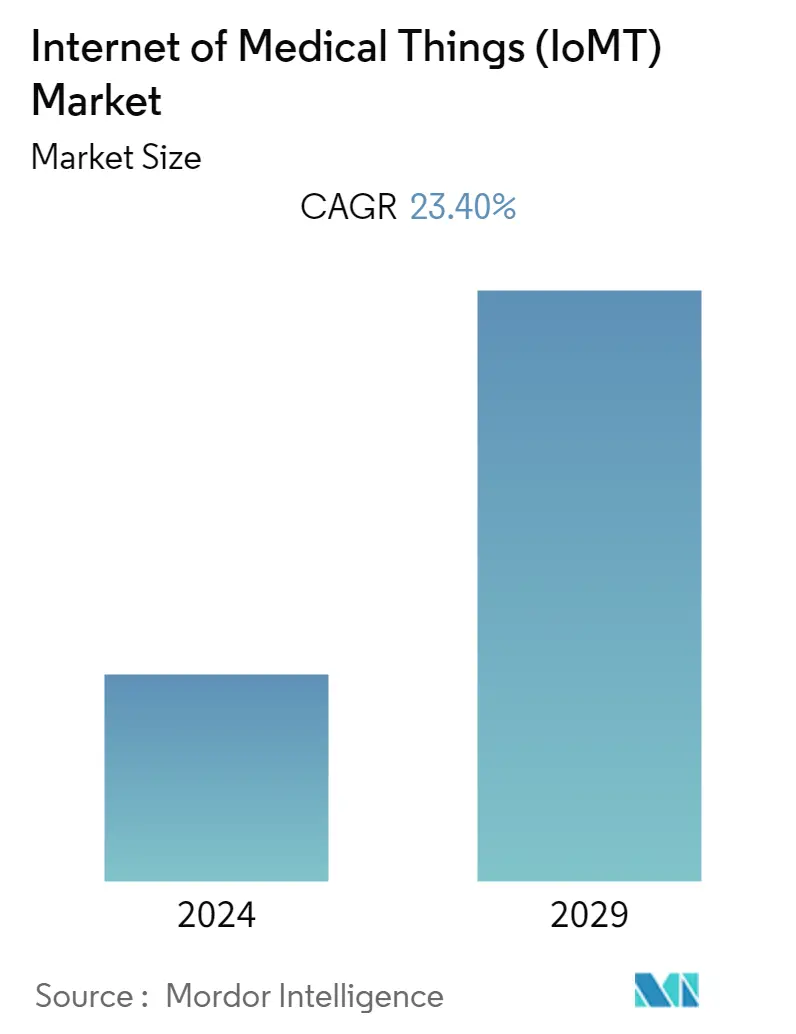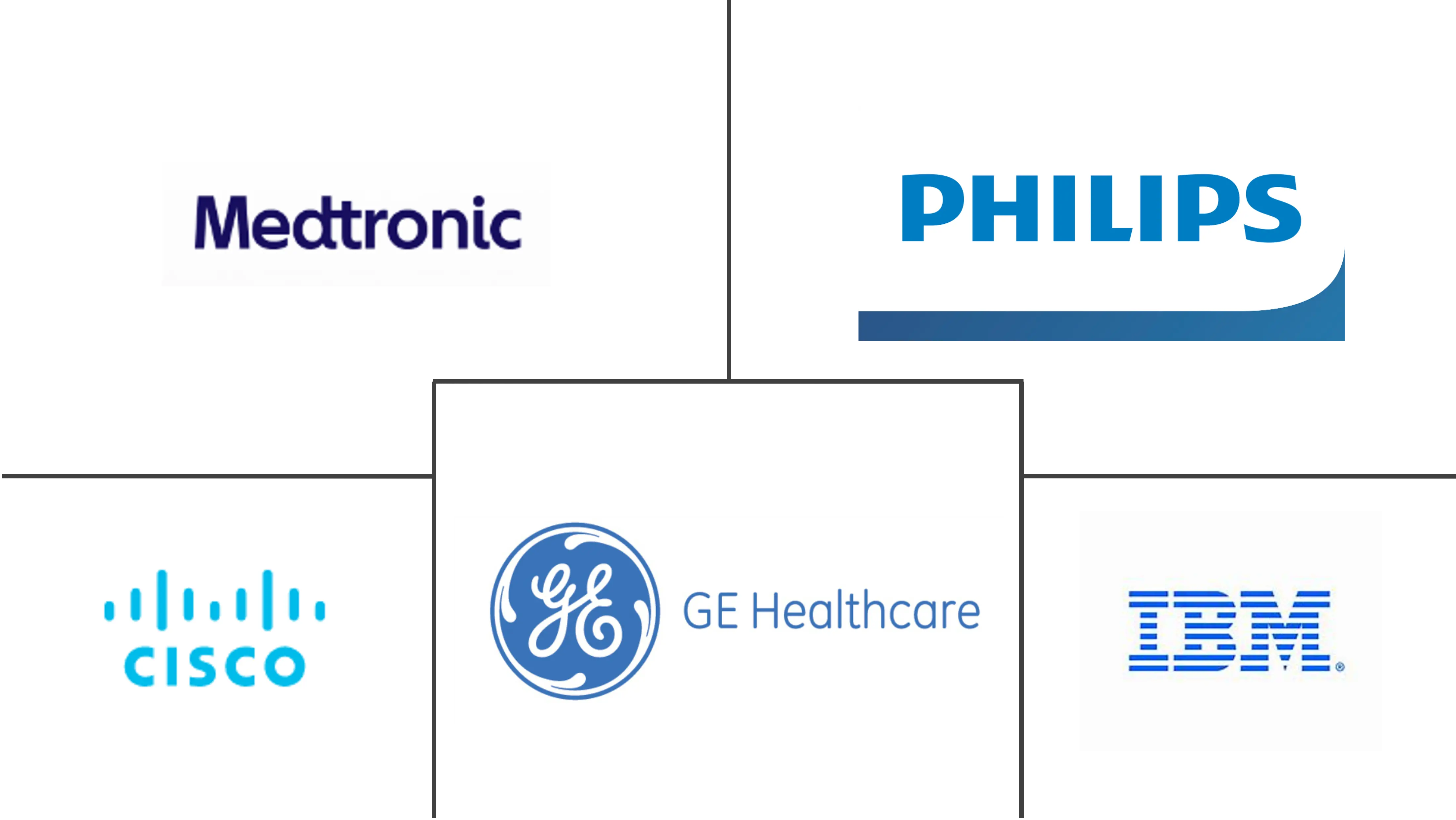Market Size of Internet of Medical Things (IoMT) Industry

| Study Period | 2019 - 2029 |
| Base Year For Estimation | 2023 |
| Forecast Data Period | 2024 - 2029 |
| CAGR | 23.40 % |
| Fastest Growing Market | Asia-Pacific |
| Largest Market | North America |
| Market Concentration | High |
Major Players
*Disclaimer: Major Players sorted in no particular order |
Internet of Medical Things Market Analysis
- The "Internet of Medical Things" (IoMT) market is anticipated to register a CAGR of 23.4% over the forecast period. The increasing need for cost reduction in medicinal delivery and the increasing penetration of connected devices are some of the significant factors influencing the growth of the IoMT market. The need to improve healthcare outcomes, as well as the evolution of high-speed networking technologies, are particularly promising areas of market advancement in IoMT devices.However, the need for proper IoT technology skills across healthcare organizations is anticipated to obstruct the market growth of the IoMT market.
- With several advantages like enhanced patient safety, reduced medical errors, seamless transfer of electronic health records (EHR), better disease management, remote monitoring of chronic diseases, and improved drug management, IoT medical devices have the potential to transform healthcare and improve patient outcomes while, at the same time, helping to reduce costs and make better-informed care decisions with more speed and ease.
- The increasing penetration of connected devices is a factor that drives the market. Connected medical devices can connect to the internet through WiFi, Bluetooth, or radio transmission. These medical devices have digital capabilities beyond their essential function of diagnosing, treating, curing, or preventing disease, allowing them to integrate with and connect to other networks and systems. The IoMT combines data (patient information or performance data), people (patients, clinicians, and caregivers), and processes (healthcare delivery and patient support) with the help of connected medical devices and mobile medical applications.
- The benefit of IoMT is that it provides fewer mistakes and accurate diagnoses at a lower cost, thereby improving healthcare outcomes that drive the market. With the Internet of Things and mobile apps, patients can send their health information to their doctors, which helps doctors keep an eye on chronic diseases.
- The cost of interoperability and connectivity solutions for different medical devices is considerably high. Moreover, IT support and maintenance services, which include modifying and upgrading software per changing user requirements and maintaining an efficient IT infrastructure, represent a recurring expenditure. This accounts for a large share of the total cost of ownership. Also, post-sale custom interface development for device integration requires additional verification and validation to ensure solution accuracy and completeness. This further increases the total cost of ownership for healthcare providers. As a result of the high costs involved, small healthcare facilities, especially in emerging countries, are reluctant to replace their legacy systems with advanced IoT-enabled devices.
- Following COVID-19, the healthcare industry saw an increased demand for healthcare solutions for critical patient treatment and monitoring. To improve the efficiency of doctors and other coroners, hospitals and local governments increased their investments in new devices and IoMT technology. The demand for IoMT is thus expected to rise following COVID-19, as is the rate of technology adoption during the forecast period, due to the healthcare industry's reliance on connected devices.
Internet of Medical Things Industry Segmentation
The Internet of Medical Things (IoMT), a subset of the Internet of Things (IoT) technologies, consists of interconnected medical and healthcare information technology devices and applications. IoMT devices transmit data over a secure network to connect doctors, patients, and medical devices such as diagnostic equipment, hospital equipment, and wearable technology.
IoMT, also known as healthcare IoT, uses automation, sensors, and machine-based intelligence, similar to general IoT devices, to reduce reliance on human intervention during routine healthcare procedures and routine monitoring operations. IoMT reduces the need for unnecessary doctor's office and hospital visits by giving patients and providers better access to a patient's health information.
The Internet of Medical Things (IoMT) Market is segmented by Devices (Wearable Devices, Stationary Devices, Implantable Devices), Products (Vital Signs Monitoring Devices, Implantable Cardiac Devices, Respiratory Devices, Imaging Systems), End Users (Hospitals, Clinics), and Geography (North America, Europe, Asia Pacific, South America, Middle East, and Africa). The market sizes and forecasts are provided in terms of value (USD million) for all the above segments.
| By Device Type | |
| Wearable Devices | |
| Stationary Devices | |
| Implantable Devices | |
| Other Device Types |
| By Product Type | |
| Vital Signs Monitoring Devices | |
| Implantable Cardiac Devices | |
| Respiratory Devices | |
| Anaesthetic Machines | |
| Imaging Systems | |
| Ventilators | |
| Other Products |
| By End Users | |||||
| Hospitals | |||||
| Clinics | |||||
|
| Geography | |
| North America | |
| Europe | |
| Asia-Pacific | |
| Latin America | |
| Middle East and Africa |
Internet of Medical Things (IoMT) Market Size Summary
The Internet of Medical Things (IoMT) market is poised for substantial growth, driven by the increasing need for cost-effective healthcare delivery and the rising adoption of connected devices. This market is characterized by the integration of medical devices with high-speed networking technologies, which enhances patient safety, reduces medical errors, and improves healthcare outcomes. The IoMT ecosystem combines data, people, and processes through connected medical devices and mobile applications, facilitating remote monitoring and better disease management. Despite these advancements, the market faces challenges such as the high cost of interoperability solutions and the need for skilled IoT professionals in healthcare organizations, which may hinder its expansion, particularly in emerging markets.
North America is expected to dominate the IoMT market, supported by a growing interest in self-health management, the prevalence of chronic diseases, and the adoption of advanced healthcare IT solutions. The region benefits from a robust infrastructure and the presence of key industry players, which contribute to its significant market share. Technological advancements and strategic partnerships among major companies are driving innovation and expanding the market. The demand for connected medical devices is further fueled by the increasing prevalence of lifestyle diseases and the need for personalized patient care. As the market continues to evolve, it presents numerous opportunities for manufacturers and healthcare providers to enhance patient outcomes and streamline healthcare delivery.
Internet of Medical Things (IoMT) Market Size - Table of Contents
-
1. MARKET DYNAMICS
-
1.1 Market Overview
-
1.2 Market Drivers
-
1.2.1 Increasing Need for Cost Reduction in Medicinal Delivery
-
1.2.2 Increasing Penetration of Connected Devices
-
1.2.3 Improving Healthcare Outcomes
-
1.2.4 Evolution of High-Speed Networking Technologies
-
-
1.3 Market Restraints
-
1.3.1 Lack of Proper IoT Technology Skills across Healthcare Organizations
-
1.3.2 High Deployment Cost of Necessary Infrastructure and Connected Medical Devices
-
-
1.4 Industry Value Chain Analysis
-
1.5 Industry Attractiveness - Porter's Five Forces Analysis
-
1.5.1 Threat of New Entrants
-
1.5.2 Bargaining Power of Buyers/Consumers
-
1.5.3 Bargaining Power of Suppliers
-
1.5.4 Threat of Substitute Products
-
1.5.5 Intensity of Competitive Rivalry
-
-
1.6 Assessment of Impact of COVID-19 on the Market
-
1.7 Technology Snapshot
-
1.7.1 Zigbee
-
1.7.2 Bluetooth
-
1.7.3 Wi-Fi
-
1.7.4 Other Connectivity Technology
-
-
-
2. MARKET SEGMENTATION
-
2.1 By Device Type
-
2.1.1 Wearable Devices
-
2.1.2 Stationary Devices
-
2.1.3 Implantable Devices
-
2.1.4 Other Device Types
-
-
2.2 By Product Type
-
2.2.1 Vital Signs Monitoring Devices
-
2.2.2 Implantable Cardiac Devices
-
2.2.3 Respiratory Devices
-
2.2.4 Anaesthetic Machines
-
2.2.5 Imaging Systems
-
2.2.6 Ventilators
-
2.2.7 Other Products
-
-
2.3 By End Users
-
2.3.1 Hospitals
-
2.3.2 Clinics
-
2.3.3 Other End Users
-
2.3.3.1 Nursing Homes
-
2.3.3.2 Long-Term Care Centers
-
2.3.3.3 Home Care Settings
-
-
-
2.4 Geography
-
2.4.1 North America
-
2.4.2 Europe
-
2.4.3 Asia-Pacific
-
2.4.4 Latin America
-
2.4.5 Middle East and Africa
-
-
Internet of Medical Things (IoMT) Market Size FAQs
What is the current Internet of Medical Things (IoMT) Market size?
The Internet of Medical Things (IoMT) Market is projected to register a CAGR of 23.4% during the forecast period (2025-2030)
Who are the key players in Internet of Medical Things (IoMT) Market?
GE Healthcare, Koninklijke Philips N.V., Medtronic plc, Cisco Systems, Inc. and IBM Corporation are the major companies operating in the Internet of Medical Things (IoMT) Market.

